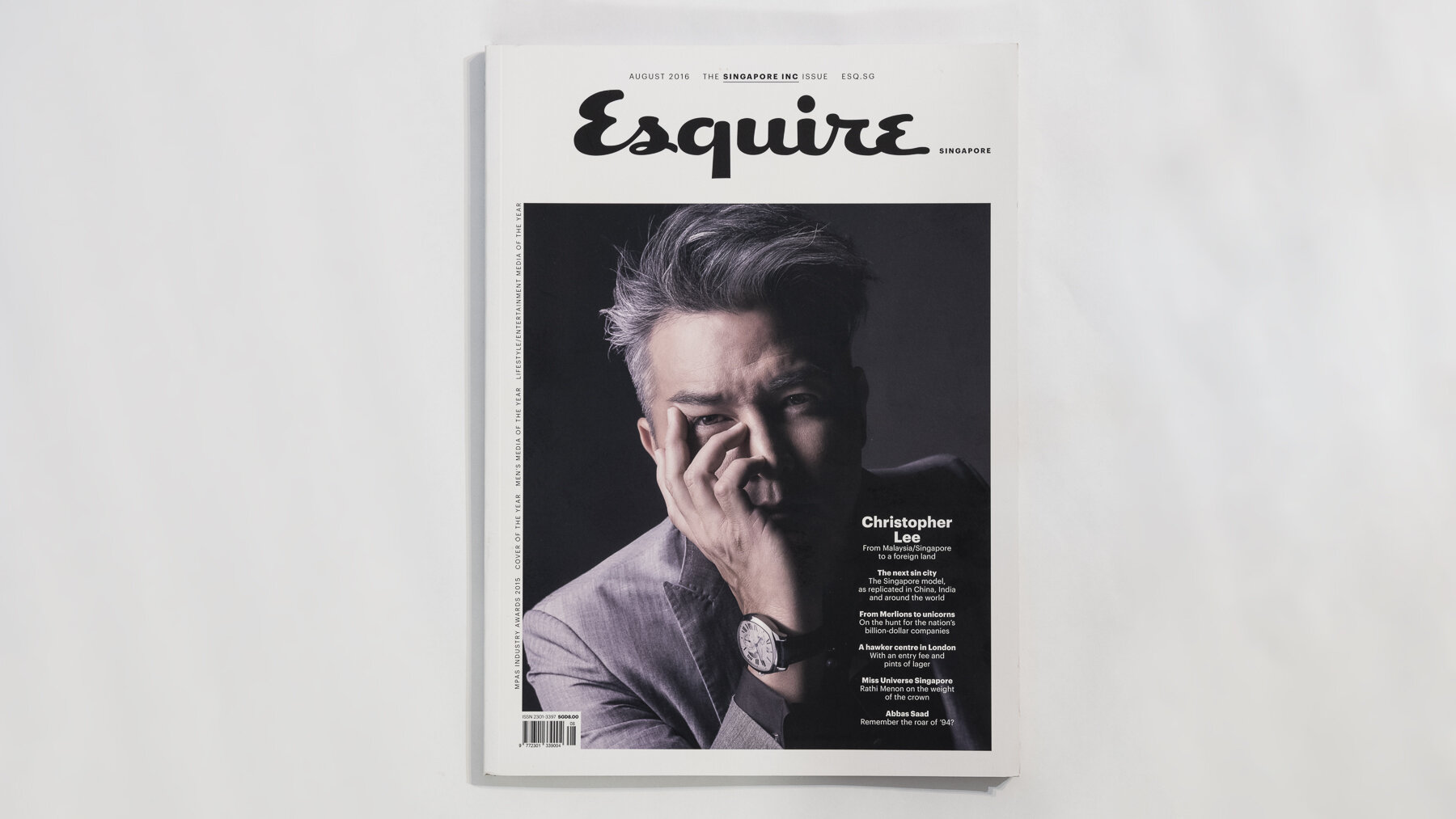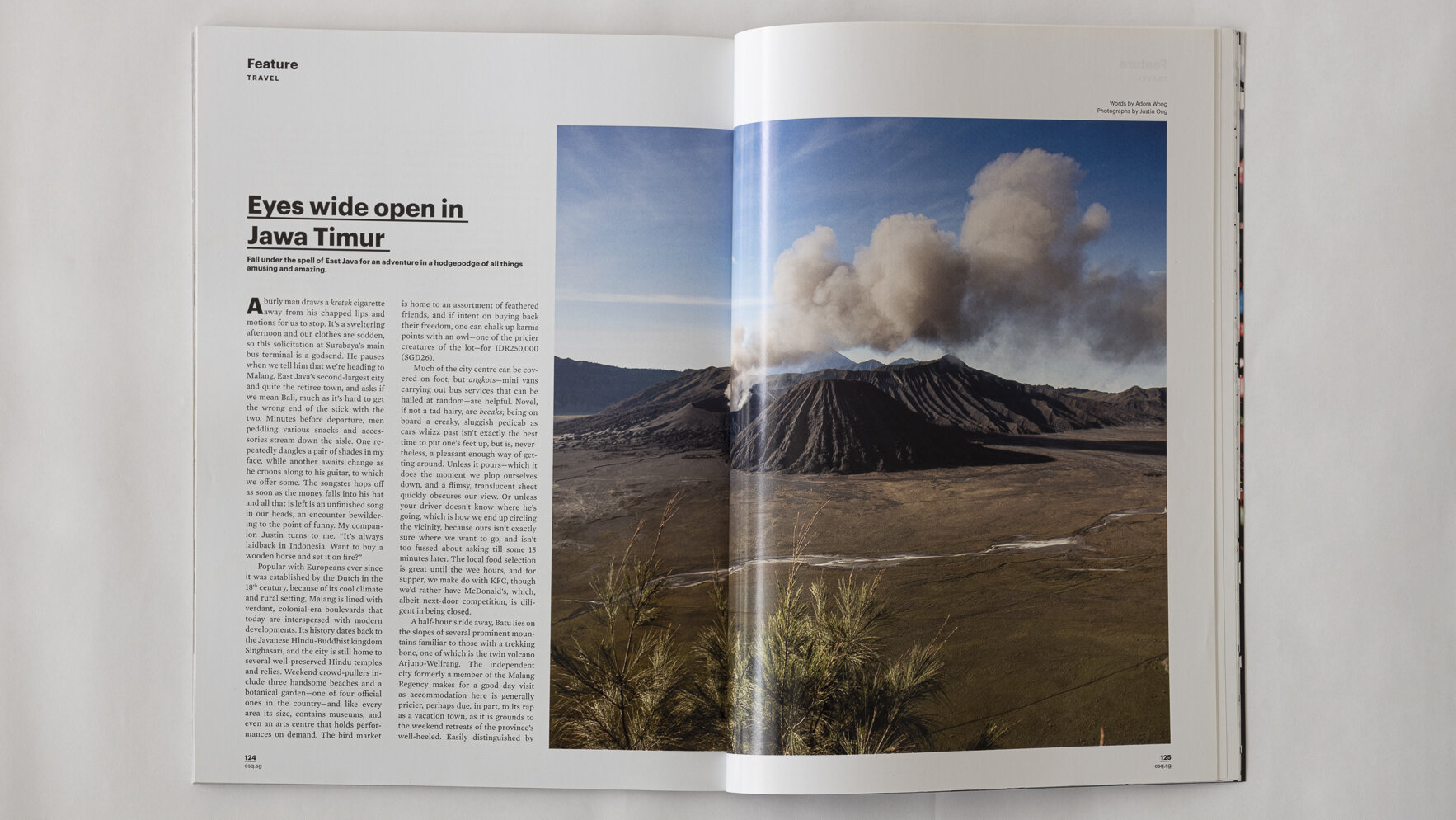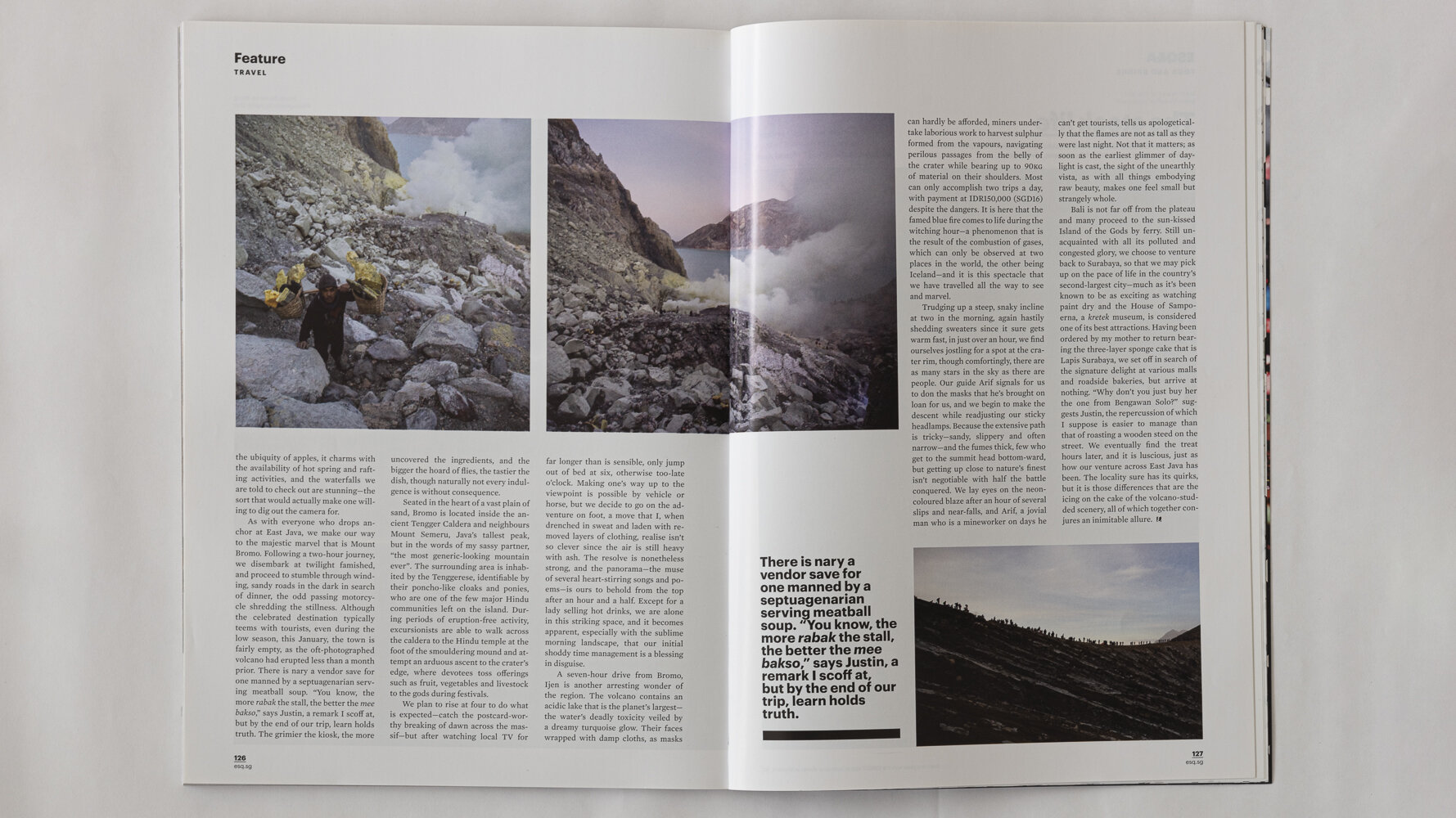EYES WIDE OPEN IN JAWA TIMUR
Fall under the spell of East Java for an adventure in a hodgepodge of all things amusing and amazing
Text by Adora Wong, Photographs by Justin Ong
A burly man draws a kretek cigarette away from his chapped lips and motions for us to stop. It’s a sweltering afternoon and our clothes are sodden, so this solicitation at Surabaya’s main bus terminal is a godsend. He pauses when we tell him that we’re heading to Malang, East Java’s second-largest city and quite the retiree town, and asks if we mean Bali, much as it’s hard to get the wrong end of the stick with two. Minutes before departure, men peddling various snacks and accessories stream down the aisle. One repeatedly dangles a pair of shades in my face, while another awaits change as he croons along to his guitar, to which we offer some. The songster hops off as soon as the money falls into his hat and all that is left is an unfinished song in our heads, an encounter bewildering to the point of funny. My companion Justin turns to me. “It’s always laid back in Indonesia. Want to buy a wooden horse and set it on fire?”
Popular with Europeans ever since it was established by the Dutch in the 18th century, because of its cool climate and rural setting, Malang is lined with verdant, colonial-era boulevards that today are interspersed with modern developments. Its history dates back to the Javanese Hindu-Buddhist kingdom Singhasari, and the city is still home to several well-preserved Hindu temples and relics. Weekend crowd-pullers include three handsome beaches and a botanical garden–and like every area its size, contains museums, and even an arts centre that holds performances on demand. The bird market is home to an assortment of feathered friends, and if intent on buying back their freedom, one can chalk up karma points with an owl–one of the pricier creatures of the lot–for IDR 250,000(SGD 26).
Much of the city centre can be covered by foot, but angkots–mini vans carrying out bus services that can be hailed at random–are helpful. Novel, if not a tad hairy, are becaks; being on board a creaky, sluggish pedicab as cars whizz past isn’t exactly the best time to put one’s feet up, but is, nevertheless, a pleasant enough way of getting around. Unless it pours–which it does the moment we plop ourselves down, and a flimsy, translucent sheet quickly obscures our view. Or unless your driver doesn’t know where he’s going, which is how we ended up circling the vicinity, because ours isn’t exactly sure where we want to go, and isn’t too fussed about asking till some 15 minutes later. The local food selection is great until the wee hours, and for supper, we make do with KFC, though we’d rather have McDonald’s, which, albeit next-door competition, is diligent in being closed.
A half-hour’s ride away, Batu lies on the slopes of several prominent mountains familiar to those with a trekking bone, one of which is the twin volcano Arjuno-Welirang. The independent city formerly a member of the Malang Regency makes for a good day visit as accommodation here is generally pricier, perhaps due, in part, to its rap as a vacation town, as it is grounds to the weekend retreats of the province’s well-heeled. Easily distinguished by the ubiquity of apple, it charms with the availability of hot spring and rafting activities, and the waterfalls we are told to check out are stunning–the sort that would actually make one willing to dig out the camera for.
As with everyone who drops anchor at East Java, we make our way to the majestic marvel that is Mount Bromo. Following a two-hour journey, we disembark at twilight famished, and proceed to stumble through winding, sandy roads in the dark in search of dinner, the odd passing motorcycle shredding the stillness. Although the celebrated destination typically teems with tourist, even during the low season, this January, the town is fairly empty, as the oft-photographed volcano had erupted less than a month prior. There is nary a vendor save for one manned by a septuagenarian serving meatball soup. “You know, the more rabak the stall, the better the mee bakso,” says Justin, a remark I scoff at, but by the end of our trip, learns holds truth. The grimier the kiosk, the more uncovered the ingredients, and the bigger the hoard of files, the tastier the dish, though naturally not every indulgence is without consequence.
Seated in the heart of a vast plain of sand, Bromo is located inside the ancient Tengger Caldera and neighbours Mount Semeru, Java’s tallest peak, but in the words of my sassy partner, “the most generic-looking mountain ever”. The surrounding area is inhabited by the Tenggerese, identifiable by their poncho-like cloaks and ponies, who are one of the few major Hindu communities left on the island. During periods of eruption-free activity, excursionist are able to walk across the caldera to the Hindu temple at the foot of the smouldering mound and attempt an arduous ascent to the crater’s edge, where devotees toss offerings such as fruit, vegetables and livestock to the gods during festivals.
We plan to rise at four to do what is expected–catch the postcard-worthy breaking of dawn across the massif–but after watching local TV for far longer than is sensible, only jump out of bed at six, otherwise too-late o’clock. Making one’s way up to the viewpoint is possible by vehicle or horse, but we decide to go on the adventure on foot, a move that I, when drenched in sweat and laden with removed layers of clothing, realise isn’t so clever since the air is still heavy with ash. The resolve is nonetheless strong, and the panorama–the muse of several heart-stirring songs and poems–is ours to behold from the top after an hour and a half. Except for a lady selling hot drinks, we are alone in this striking space, and it becomes apparent, especially with the sublime morning landscape, that our initial shoddy time management is a blessing in disguise.
A seven-hour drive from Bromo, Ijen is another arresting wonder of the region. The volcano contains an acidic lake that is the planet’s largest–a dreamy turquoise glow. Their faces wrapped with damp clothes, as masks can hardly be afforded, miners undertake laborious work to harvest sulphur formed from the vapours, navigating perilous passages from the belly of the crater while bearing up to 90kg of material on their shoulders. Most can only accomplish two trips a day, with payment at IDR150,00 (SGD 16) despite the dangers. It is here that the famed blue fire comes to life during the witching hour–a phenomenon that is the result of the combustion of gases, which can only be observed at two places in the world, the other being Iceland–and it is this spectacle that we have travelled all the way to see and marvel.
Trudging up a steep, snaky incline at two in the morning, again hastily shedding sweaters since it sure gets warm fast, in just over an hour, we find ourselves jostling for a spot at the crater rim, though comfortingly, there are as many stars in the sky as there are people. Our guide Arif signals for us to don the mask that he’s brought on loan for us, and we begin to make the descent while readjusting our sticky headlamps. Because the extensive path is tricky–sandy, slippery and often narrow–and the fumes thick, few who get to the summit head bottom-ward, but getting up close to nature’s finest isn’t negotiable with half the battle conquered. We lay eyes on the neon-coloured blaze after an hour of several slips and near-falls, and Arif, a govial man who is a mineworker on days he can’t get tourist, tell us apologetically that the flames are not as tall as they were last night. Not that it matter; as soon as the earliest glimmer of daylight is cast, the sight of the unearthly vista, as with all things embodying raw beauty, makes one feel small but strangely whole.
Bali is not far off from the plateau and many proceed to the sun-kissed Island of the Gods by ferry. Still unacquainted with all its polluted and congested glory, we choose to venture back to Surabaya, so that we may pick up on the pace of life in the country’s second-largest city–much as it’s been known to be as exciting as watching paint dry and the House of Sampoerna, a kretek museum, is considered one of its best attractions. Having been ordered by my mother to return bearingthe three-layer sponge cake that is Lapis Surabaya, we set off in search of the signature delight at various malls and roadside bakeries, but arrive at nothing. “Why don’t you just buy her the one from Bengawan Solo?” suggest Justin, the repercussion of which I suppose is easier to manage than that of roasting a wooden steed on the street. We eventually find the treat hours later, and it is luscious, just as how our venture across East Java has been. The locality sure has its quirks, but it is those differences that are the icing on the cask of the volcano-studded scenery, all of which conjures an inimitable allure.



